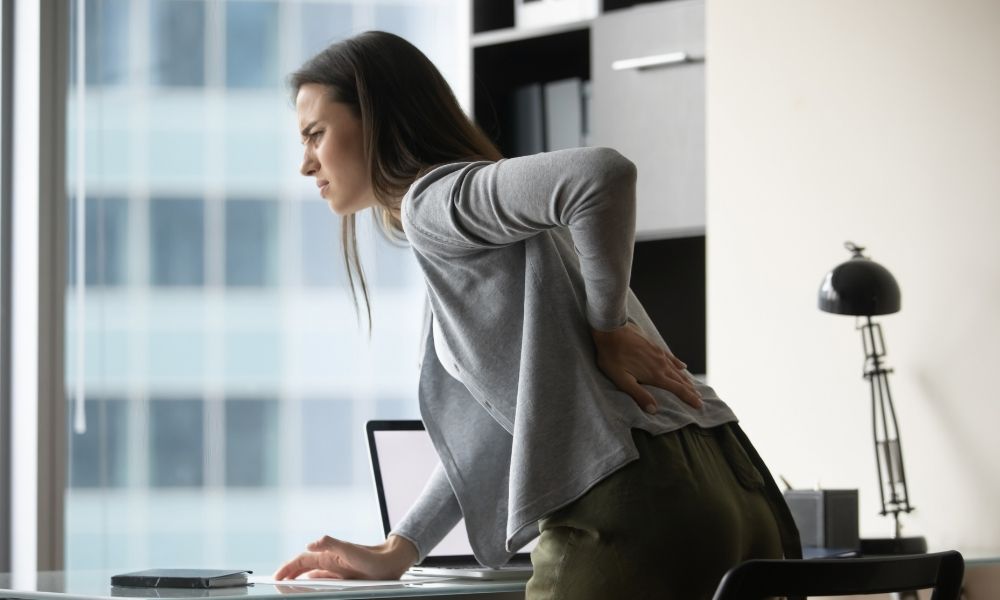


13 Aug Loosen Stiff Lower Back Muscles: 10 Stretches for Instant Relief
Sitting for endless hours in an office chair might be a nightmare for those with chronic back pain issues.
Well, what we know so far is, most of the time, the reason for back pain is tight back muscles. But how to loosen tight lower back muscles, you might wonder.
In general, stiff back treatment includes both medications as well as exercises.
As the reasons can range from bad posture to genetics to inappropriate form during the gym, the treatments can also vary.
So, if you’ve been curious about how to loosen lower back muscles, we’re here with lower back pain exercises for older adults as well as young people to have instant relief from muscle tightness.
How to Loosen Tight Lower Back Muscles: Top 10 Stretches
In case you’re wondering how regular stretching is helpful to loosen chronic tight back muscles, then the answer is quite simple.
Stretching allows vigorous circulation and transportation of nutrients and oxygen via your blood throughout your body.
So, now if you’ve got a feeling of very tight lower back muscles, hop on the mat and perform these 10 stretches right away.
Disclaimer: This article is for general informational purposes and doesn’t substitute any professional or medical advice.
#1. Pigeon Pose


Pigeon pose is one excellent stretching move to loosen up the glutes and hips.
This pose stretches the deep hip rotator muscles that control hip stability.
Steps to Perform Pigeon Pose:
1: To begin with, start in a tabletop position with your knees directly below your hips and your hands a little over your shoulders.
2: Carefully slide your right knee forward and outside to your right wrist. [key step]
3: Place your right foot in front of your left knee while resting the outside of your right knee on the floor.
4: Slowly and carefully slide your left leg backward and straighten the knee. Meanwhile, lower the front of your left thigh and try to keep it as close as possible to the floor.
5: Lower the outside of your right buttock on the floor.
6: Place your right foot in front of your left hip and push with your fingertips on the floor.
7: Squaring your pelvis, try to roll your left hip joint in front of your right hell.
8: Push with your fingertips against the floor, lengthen your spine, and look straight.
#2. Inner Thigh Stretch
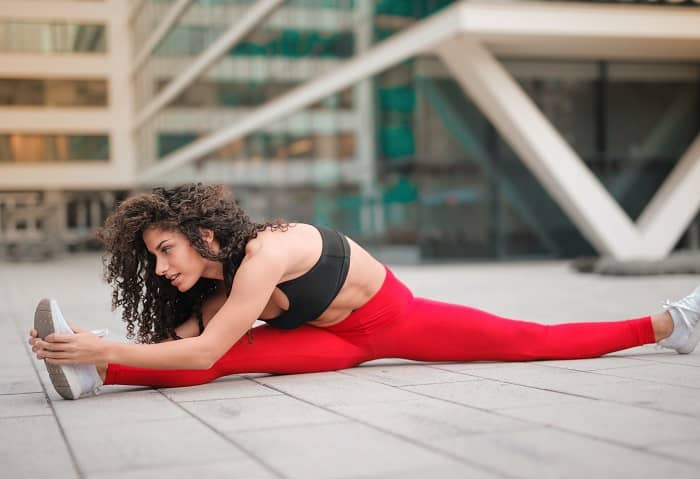


Stretching the muscles connected to the pelvis can help brilliantly with hip mobility and back pain reduction.
Inner thigh stretch releases the abductors which often creates an obstacle when glutes, core, and hip muscles are weak.
This sequentially leads to restricted hip movement because of tightened hip muscles.
Steps to Perform Inner Thigh Stretch:
1: Sit down on the floor with your legs placed forward on the ground.
2: Open your legs wide apart.
3: Flex your feet and involve your quads.
4: For a deeper stretch, slowly lean forward as low as possible.
#3. Child’s Pose
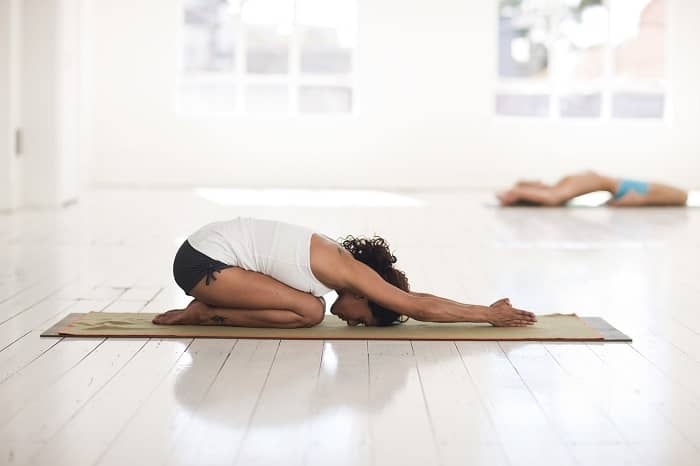


The child’s pose is one stretch to relieve back pain which is as effective as it is popular.
This pose can certainly loosen up the tight lower back and ensure more flexibility.
Furthermore, a child’s pose is a dynamic movement that lengthens the muscles and heals the soreness.
Steps to Perform Child’s Pose:
1: Start on all your fours with your knee and arms on the ground.
2: Spread your knees a little and bring your toes to kiss together.
3: Sit with your hips placed back on your heels.
4: Extend your arms out while you fold yourself forward and place your palms right on the floor.
5: Slowly relax your hips on your heels and drop your head and chest downward and try to place your forehead on the floor.
6: Hold this pose for 20 -30 seconds.
#4. Knee-to-Chest Stretch
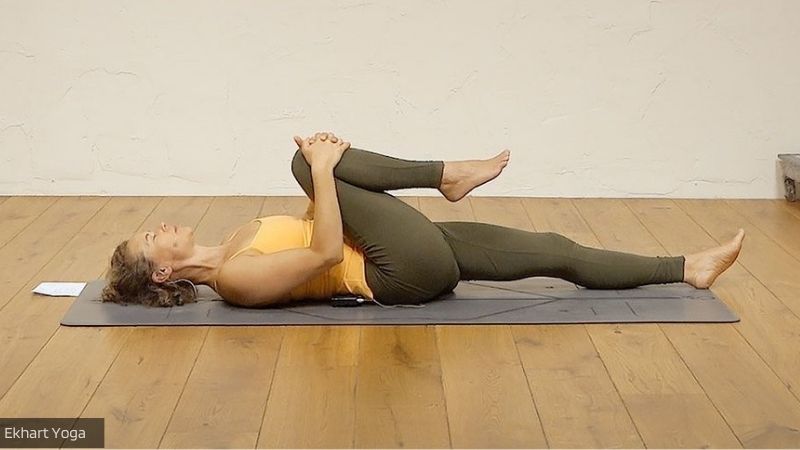


If you tend to have a tight lower back when standing, a back extension can put more pressure on your spine, leading to pains.
In this case, try a knee-to-chest stretch.
This stretching exercise can be used to align the pelvis, stretch the rear end and lower back muscles.
Steps to Perform Knee-To-Chest Stretch:
1: Lie on your back with your legs bent and feet placed flat on the floor.
2: Place your hands right below your knee caps.
3: Slowly guide your knees towards your chest.
4: Now place your hands on your shins and carefully pull your knees even closer.
5: Hold this position for 20-30 seconds.
#5. Supine Figure 4 Stretch



If you’re suffering from back pain that travels to your legs, and you feel lower back stiffness after sitting, the supine figure 4 stretch might provide some relief.
As it targets deep buttock muscles, you can feel a sense of relief in your lower back stiffness.
Steps to Perform Supine Figure 4 Stretch:
1: To begin with, lie with your knees bent and feet placed right on the floor.
2: Lift your right foot and place the right ankle on your left thigh.
3: Creating the shape of “4” with your legs, open your right knee outward.
4: While holding this position, reach your hands behind your left thigh.
5: Using your hand, lift your left foot and guide it to bring your left knee towards your chest.
6: Hold this position for a few seconds, then release it on the floor; then switch sides.
#6. Cat-Cow Pose
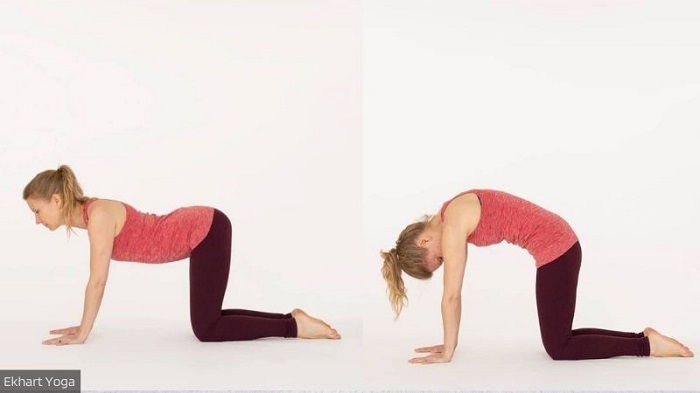


If you’re one such person who is dealing with a stiff lower back in the morning, the cat-cow pose is the best stretch to find relief.
It is one of the popular poses that take the spine through flexion and extension stretch.
Not to mention, yoga is a known stiff back treatment that helps reduce chronic muscle tightness.
Steps to Perform Cat-Cow Pose:
1: Start on all your fours. Place your hands underneath your shoulders and your knees under your hips.
2: Gently arc back your spine towards the ceiling, similar to how a cat stretches her back making a round shape.
3: Hold the position for only a few seconds then relax.
4: Now, let your stomach fall downward towards the floor making an arched lower back. Hold it for another few seconds.
#7. Lumbar Stretch
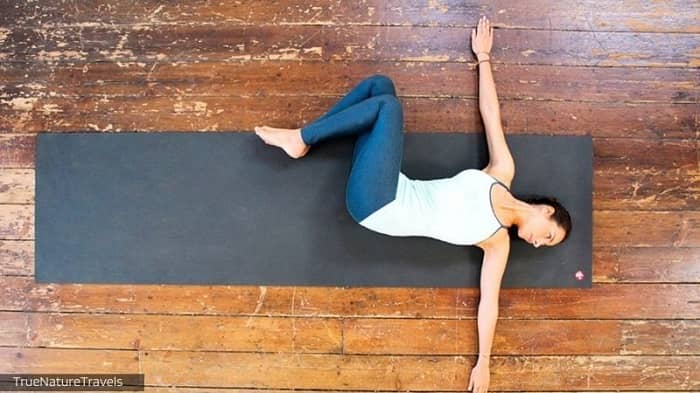


You can easily loosen tight lower back muscles at home when you know how to perform this stretch.
If performed correctly, lumber stretch could be one of the most promising answers for your chronic tight back muscles.
Steps to Perform Lumbar Rotation:
1: Begin by lying flat on the floor with knees bent and feet on the ground.
2: Open both your arms outwards to the side.
3: Bend your knees towards the left while sticking your feet, shoulders, and arms on the floor.
4: Hold the position for 10 -20 seconds before coming back to the center.
5: Now, lower your knees to the opposite side.
6: Perform this stretch 3-5 times.
#8. Bridge Pose
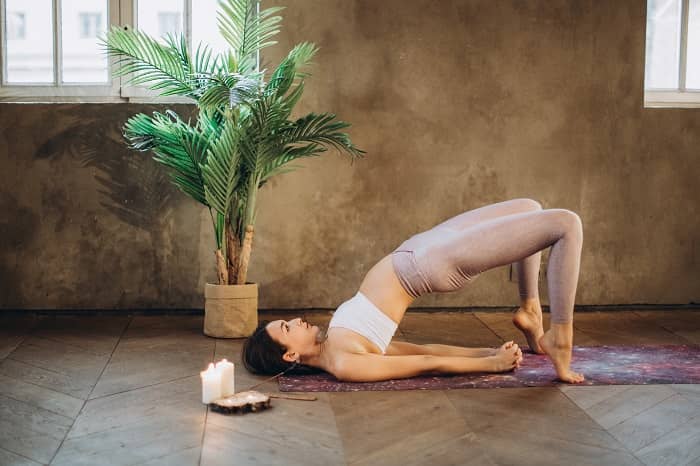


Bridge pose is a common answer to—how to loosen a stiff lower back.
To be precise, it stretches your spine, thighs, neck, and hip flexors.
Not only this, it’s therapeutic for people dealing with high BP and provides relief in stress, constipation, and mild depression as well.
Steps to Perform Bridge Pose:
1: Lie on your back and bend your knees with your feet placed right on the floor.
2: Place your arms straight along your body with palms facing the ground.
3: Keeping your feet, shoulders, and arms on the ground, lift your hip towards the ceiling.
4: Hold the position for 4-5 seconds, then slowly come back to the starting position.
5: Repeat it 5-6 times.
#9. Forearm Plank
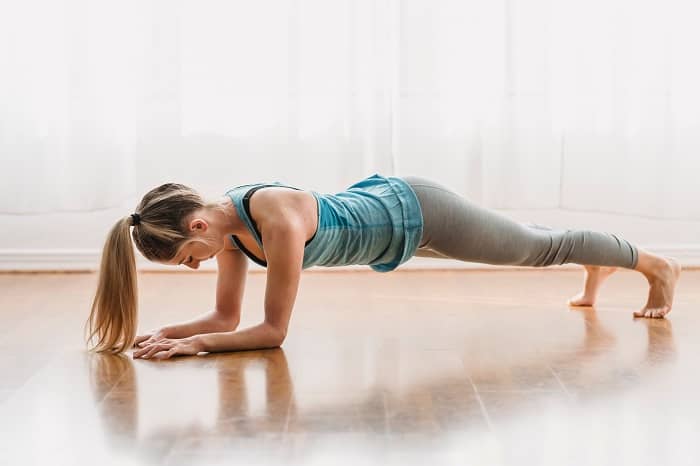


From activating your core to strengthening your lower back muscles, this variation of the plank has multi-benefits.
To elaborate, it targets multiple muscle groups and strengthens legs, arms, back, and, simultaneously, builds core.
And that’s why this pose is effective to loosen tight lower back muscles in minutes.
Steps to Perform Forearm Plank:
1: Take the push-up position and drop your forearms lightly on the mat under your shoulders.
2: Bring your arms parallel to one another in a comfortable position.
3: Kick through your heels and engage your core.
#10. Hamstring and Hip Flexor
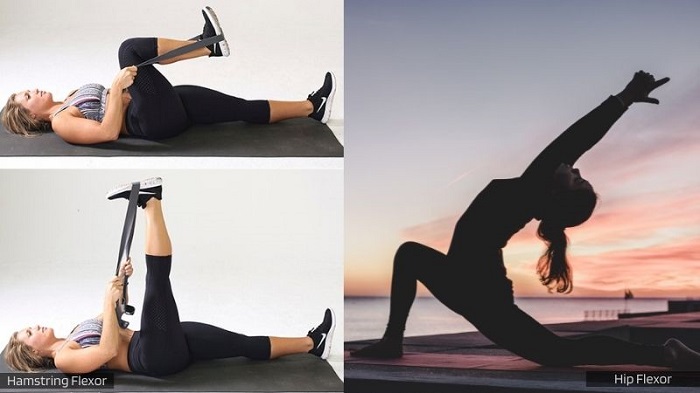


For immediate back tension relief, you can rely on continuous hamstring and hip flexor stretches.
It not only loosens your stiff lower back but also improves your posture.
As hip flexors are the key muscles in moving your lower body, hip flexor stretch will help prevent tearing of muscles because of being too tight or due to a sudden movement.
Steps to Perform Hamstring Pose:
1: Lie down on your back.
2: Loop a towel or resistance band around your left toe and hold the ends with both hands.
3: Slowly pull the band and lift your leg straight up, keeping your right leg on the floor.
4: Bring your left leg up until you feel a stretch in your back and calf.
5: Hold it for a minimum of 15 seconds then relax.
6: Switch legs and repeat at least 5 times.
Steps to Perform Hip flexor:
1: Kneel on both knees with the bottom on your heels.
2: Press your arms on the mat while leaning forward.
3: Place your hands shoulder-width apart and avoid elbow locking by bending it slightly.
4: Bring your left knee forward between your arms and place the left foot on the ground making a 90-degree angle.
5: Straighten your upper body and use your hands to balance.
6: Stretch your right leg backward and press the right knee into the mat.
7: Rest the top of your right foot on the mat.
8: Slowly try to lean forward a little and maintain it for 20 seconds.
9: Return to the starting position and repeat it with the opposite leg.
So, now we hope you have got a good idea of how to loosen tight lower back muscles.
These gentle lower back stretching and exercises will help you get out of bed and get moving again.
Plus, all these exercises are feasible and can be efficiently done at home.
So, now you can stop your uncomfortable lower back stiffness from kicking your butt with these 10 stretches.
Now, people suffering from lower back stiffness often have more to ask than just how to loosen tight lower back muscles.
Hence, we are here with the answers to some of the most frequently asked questions.
Q&As
These should answer any and all of your queries related to back pain. Drop in the comments section if you don’t find your question here, and we’ll get back to you.
QUES 1: What causes tight lower back muscles?
Ans: Injury to bone structure, joints, muscles, and other tissues can cause tightness in lower back muscles.
Some common reasons for tight lower back muscles are:
- Spondylolisthesis
- Arthritis
- Poor posture
- Skeletal abnormalities
- Strains and sprains
- Kidney stones
- Infections, such as discitis
QUES 2: How do I know if my back pain is muscle or spine?
Ans: For proper treatment, it’s vital to differentiate between muscle pain and spinal pain.
Symptoms of spine-related pain:
- Pain at rest as well as in movement
- Radiating pain
- Dull/aching and sharp pain
- Electric Pain
- Weakness
Symptoms of muscle-related pain:
- Muscle tightness
- Pain with movement and at rest
- Dull/aching and sharp pain
QUES 3: How do you tell if lower back pain is muscle or disc?
Ans: The basic difference to locate whether your lower back pain is related to muscle or disc is that if it hurts both while bending forward and returning to the upright position, then it is disc pain.
Whereas, if it hurts more while returning to the upright position as compared to forward bending, then it’s muscle pain.
Other symptoms of disc pain are:
- Increased back pain with prolonged sitting and frequent bending.
- Increased back pain because of coughing, sneezing, and even laughing.
- Numbness or pin-needles like pain radiating into the affected area.
QUES 4: What does a slipped disc feel like in the lower back?
Ans: Slip disc makes you feel more pain in your buttocks, calves, and thighs.
You might face problems while bending and straightening your back as well.
QUES 5: How do you sleep with a tight lower back?
Ans: Sleeping positions have a major role to play in your lower back stiffness. It can create as well as cure the pain.
The three best sleeping positions with a tight lower back are:
- Stomach sleeping
- Back sleeping with pillows placed under the knees.
- Side sleeping with pillows placed between the legs.
QUES 6: What position should I sleep in if my back hurts?
Ans: The ideal sleeping position if your back hurts is the side sleeping.
Place extra pillows between your legs for a more comfortable position.
QUES 7: Is lying on the floor good for back pain?
Ans: This is quite debatable. While it can reduce back pain for some, it may increase it for others.
Not to mention, it is not ideal for people with chronic back pain.
Final Words
Battling lower back muscle stiffness, one major reason for chronic pain is no joke at all!
However, lower back stiffness and pain is a common issue and its causes dissent from injury to bad posture to skeleton abnormality.
And because of its drastic effects on overall health and well-being, it’s considerable to know how to loosen tight lower back muscles.
Even though it’s always better to take medical advice for chronic stiff back muscles, you can get instant relief from not-so-severe lower back tightness by continuing to perform several exercises, poses, and stretches.
So, what are you waiting for?
Get rid of your uncomfortable back and put your painless foot forward!
READ NEXT:
Pectoral Exercises for Perkier Breasts [With and Without Weights]



No Comments